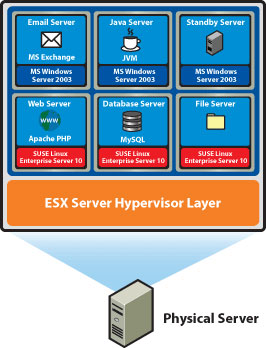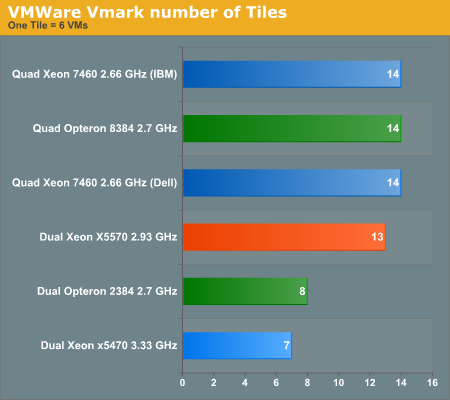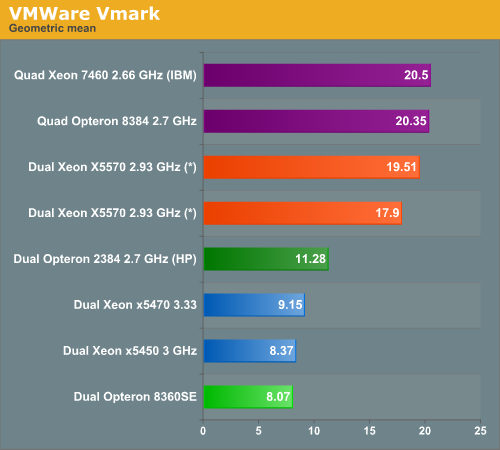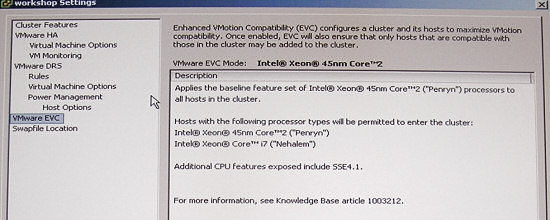The Best Server CPUs part 2: the Intel "Nehalem" Xeon X5570
by Johan De Gelas on March 30, 2009 3:00 PM EST- Posted in
- IT Computing
Virtualization (ESX 3.5 Update 2/3)
More than 50% of the servers are bought to virtualize. Virtualization is thus the killer application and the most important benchmark available. VMware is by far the market leader with about 80% of the market. However, we encountered - once again - serious issues in getting ESX installed and running on the newest platform. ASUS told us we need the ESX Update 4, which we do not yet have in the labs. We are doing all we can to make sure that our long awaited hypervisor comparison will be online in April, so stay tuned. Since we have not been able to carry out our own virtualization benchmarking, we turn to VMware's VMmark.
VMware VMmark is a benchmark of consolidation. Several virtual machines performing different tasks are consolidated, creating a tile. A VMmark tile consists of:
- MS Exchange VM
- Java App VM
- Idle VM
- Apache web server VM
- MySQL database VM
- SAMBA fileserver VM
The first three run on a Windows 2003 guest OS and the last three on SUSE SLES 10.

Let us first see how many tiles (six VMs per tile) each server can support:

The newest Xeon is shattering records again: with 13 tiles (in 72GB) it can consolidate by far the most VMs in a dual socket server. It is already dangerously close to the quad socket servers with up to 128GB of RAM. It is important to note that once you use more than one DIMM per channel, the maximum DDR3 speed is 1066. Once you fill up all slots (three DIMMs per channel, nine DIMMs per CPU), the DDR3 memory is running at 800MHz. Intel's official validation results can be found here.
Nevertheless, the performance impact of lower DDR3 speeds is not large enough to offset the advantage of three DIMMs per channel: up to 18 DIMMs in a dual configuration is a record. So far, AMD's latest Opteron held the record with eight DIMMs per CPU, or a maximum of 16 per dual socket server. AMD' supports up to three DIMMs per channel at 800MHz. Once you use four DIMMs (eight per CPU) per channel, the clock speed falls back to 533MHz. That is also a reason, besides pure performance, why Intel can support 13 tiles or 78 light VMs per server: Intel used 72GB of DDR3 at 800MHz. AMD is stuck at eight tiles for the moment: the dual Opteron servers get 64GB (at 533MHz) at the most.
After a benchmark run, the workload metrics for each tile are computed and aggregated into a score for that tile. This aggregation is performed by first normalizing the different performance metrics such as MB/second and database commits/second with respect to a reference system. Then, a geometric mean of the normalized scores is computed as the final score for the tile. The resulting per-tile scores are then summed to create the final metric.

(*) preliminary benchmark data
World switch times from VM to hypervisor have been reduced to 40% of those of Clovertown (Xeon 53xx), and EPT is good for a 27% performance increase. Add a massive amount of memory bandwidth, and we understand why the Nehalem EP shines in this benchmark. The scores for the Xeon X5570 are however preliminary: we have seen scores range from 17.9 to 19.51, but always with 13 tiles. The ESX version was not an official version ("VMware ESX Build 140815") which will probably morph into ESX 3.5 Update 4. AMD's results might also get a bit better with ESX 3.5 Update 4, so take the results with a grain of salt, but they give a good first idea. There is little doubt that the newest Xeon is also the champion in virtualization.
Both AMD and Intel emphasize that you can "vmotion" across several generations. AMD demonstrated that it is possible to migrate from the hex-core Istanbul to the quad-core Barcelona, while Intel demonstrated vmotion between "Harpertown" and "Nehalem".

It will be interesting to see how far you can go with this in practice. In theory you can go from Woodcrest to Nehalem. It is funny to see that Intel (and AMD to a lesser degree) have to clean up the mess they made with the incredibly chaotic ISA SIMD extensions: from MMX to more SSE extensions then we care to remember.










44 Comments
View All Comments
Veteran - Wednesday, April 1, 2009 - link
I didn't mean to offend you, because i can imagine how much time it takes to test hardware properly. And i personally think that OLTP/OLAP testing is very innovative and needed. Because otherwise people would have no idea what to buy for servers. You cannot let you server purchase be influenced with meaningless (for servers) simple benchmarks like 3D 2006/Vantage/FPS test etc.You guys always are doing a great a job at testing any piece of hardware, but it is just feeling to much biased towards Intel. For example, at the last page of this review you get a link to Intel resource Center (in the same place as the next button). If you have things like that, you are not (trying to be) objective IMO.
JohanAnandtech - Wednesday, April 1, 2009 - link
Thank you for clarifying in a very constructive way."the last page of this review you get a link to Intel resource Center"
I can't say I am happy with that link as it creates the wrong impression. But the deal is: editors don't involve in ad management, ad sales people don't get involved when it comes to content.
So all I can say is to judge our content, not our ads. And like I said, it didn't stop us from claiming that Shanghai was by far the best server CPU a few months ago. And that conclusion was not on many sites.
Veteran - Wednesday, April 1, 2009 - link
Thanks for clarrifying this matter.But ad sales people should know this creates the wrong impression. A review site (for me at least) is all about objectivity and credibility. When you place a link to Intel's Resource Center at the end of every review, it feels weird. People on forums already call Anandtech, Inteltech. And i don't think this is what you guys want.
I always liked Anandtech since when I was a kid, and I still do. You guys always have one of the most in-depth reviews (especially on the very technical side) and I like that. But you guys are gaining some very negative publicity on the net.
BaronMatrix - Tuesday, March 31, 2009 - link
Unfortunately, I don't buy from or recommend criminals.carniver - Wednesday, April 1, 2009 - link
AMDZone is the biggest joke on the internet. I just went there to see how the zealots like abinstein are still doing their damage control; just like before he went on rambling how the Penryn is still weak against Shanghai, and the old and tired excuses like how if people all bought AMD they can drop in upgrades etc etc. ZootyGray...he's the biggest joke on AMDZone. None of them had the mental capacity to accept AMD has been DEFEATED, which is disappointing but funny to say the leastduploxxx - Wednesday, April 1, 2009 - link
It's not just AMDZone, you are just the opposite. Its like in Woodcrest and conroe times, it's not because the high-end cpu is the best of all that the rest of the available cpu's in the line is by default better. It's all about price performance ratio. Like many who were buying the low-end and think they had bought the better system, well wrong bet.As mentioned before, why not test the mid range that is where the sales will be. Time to test 5520-5530 against 2380-82 after all those have the same price.
carniver - Wednesday, April 1, 2009 - link
Your argument is valid, however, it just so happens that for low end 1S systems the Penryns are doing just fine against the Shanghais, for higher end 2S systems they used to be limited by memory bandwidth and AMD pulls ahead. No more is this the case, Intel now beats AMD in their own territory.CHADBOGA - Tuesday, March 31, 2009 - link
You probably also can't afford to buy a computer, so I doubt that Intel will be too concerned with your AMDZone insanity. LOL!!!!smilingcrow - Tuesday, March 31, 2009 - link
Those grapes you are chewing on sure sound sour to me. Try listening to a few tracks by The Fun Loving Criminals to help take away the bad taste.cjcoats - Tuesday, March 31, 2009 - link
There's more to HPC applications than you indicate: environmental modeling apps, particularly, tend to be dominated by memory access patterns rather than by I/O or pure computation. Give me a ring if you'd like some help with that -- I'm local for you, in fact...